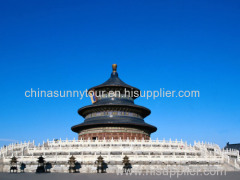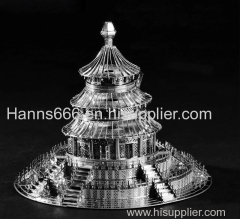

The Temple of Heaven
| Place of Origin: | Beijing |
|---|
Company Profile
| Location: | Beijing, China (Mainland) |
|---|---|
| Business Type: | Agent, Service |
| Main Products: | Three Gorges, Tianjing Pire Transfer, Yangtze Cruise, Beijing One Day Tour, Beijing Private Tour Guide |
Product Detail
| Brand Name: | chinasunnytour |
|---|
Product Description
The temple complex was constructed during the reign of Emperor Yongle of the Qing Dynasty (1420). It has become a grand and magnificent complex after its extension under the reign of Emperor Jiajing of the Ming Dynasty and its renovation under the reign of the Emperor Qianlong of the Qing Dynasty. After the founding of the New China (1949), the central government has put in a great deal of financial resources for its preservation and maintenance. Through the ages, the temple complex, situated in the Southeastern part of Beijing, has turned out to be the portrait of the ancient oriental civilization with its profound cultural connotation and magnificent architectural style. It served as a complex of sacrificial buildings for the Ming and Qing emperors and symbolizes the relationship between Earth and Heaven to strengthen Confucian social estate system. It was listed as a "National-Level Cultural Relics Preservation Unit" by the State Council in 1961 and the "World Cultural Heritage" by the UNESCO in 1998. In 2009, it was listed as the largest existing complex of ancient sacrificial buildings in China by the China World Records Association.
The Temple of Heaven covers an area of 2.72 million square meters, even larger than the Forbidden City (The Palace Museum). It is enclosed with a long wall and comprises three main groups of constructions, namely the Hall of Prayer for Good Harvests (Qiniandian), the Imperial Vault of Heaven (Huangqiongyu) and the Circular Mound Altar (Yuanqiu). The Circular Mound Altar is built on the central axis. The whole complex is surrounded by two cordons of walls; the outer wall has a semi-circular northern end, representing Heaven, and a rectangular southern end, representing the Earth. The Circular Mound Altar in the south and the Hall of Prayer for Good Harvests in the north are both on the north-south axis and are separated by wall. The Circular Mound Altar complex also includes the Imperial Vault of Heaven. The Hall of Prayer for Good Harvests also includes the Hall of Imperial Zenith and the Gate to the Hall. The Hall of Prayers for Good Harvests was constructed in the 18th year of the reign of Emperor Yongle of the Ming Dynasty (1420). This hall, originally called "the Great Hall of Prayers", is rectangle in shape. It is 38.2 meters high and 24.2 meters in diameter. It has four inner, twelve middle and twelve outer pillars, representing the four seasons, twelve months and twelve traditional Chinese hours respectively. Combined together, the twelve middle and twelve outer pillars represent the traditional solar term. The Hall of Prayers for Good Harvests is the only existing hall type building and the main building of the Temple of Heaven. The Circular Mound Altar was constructed in the 9th year of the reign of Emperor Jiajing of the Ming Dynasty. In ancient China, a great sacrificial ceremony to the heaven would be held on it on each winter solstice. The Echo Wall is the enclosing wall of the Temple of Heaven and can transmit sounds over large distances due to the eaves of the wall and the hermetically laid bricks.
· Hours:8:00am to 4:30pm
· Price:35 RMB admission fee


